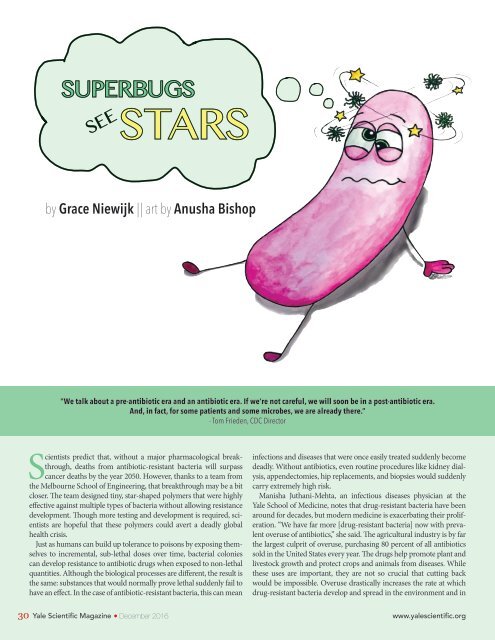YSM Issue 90.1
Create successful ePaper yourself
Turn your PDF publications into a flip-book with our unique Google optimized e-Paper software.
SUPERBUGS<br />
SEE<br />
STARS<br />
by Grace Niewijk || art by Anusha Bishop<br />
“We talk about a pre-antibiotic era and an antibiotic era. If we’re not careful, we will soon be in a post-antibiotic era.<br />
And, in fact, for some patients and some microbes, we are already there.”<br />
- Tom Frieden, CDC Director<br />
Scientists predict that, without a major pharmacological breakthrough,<br />
deaths from antibiotic-resistant bacteria will surpass<br />
cancer deaths by the year 2050. However, thanks to a team from<br />
the Melbourne School of Engineering, that breakthrough may be a bit<br />
closer. The team designed tiny, star-shaped polymers that were highly<br />
effective against multiple types of bacteria without allowing resistance<br />
development. Though more testing and development is required, scientists<br />
are hopeful that these polymers could avert a deadly global<br />
health crisis.<br />
Just as humans can build up tolerance to poisons by exposing themselves<br />
to incremental, sub-lethal doses over time, bacterial colonies<br />
can develop resistance to antibiotic drugs when exposed to non-lethal<br />
quantities. Although the biological processes are different, the result is<br />
the same: substances that would normally prove lethal suddenly fail to<br />
have an effect. In the case of antibiotic-resistant bacteria, this can mean<br />
infections and diseases that were once easily treated suddenly become<br />
deadly. Without antibiotics, even routine procedures like kidney dialysis,<br />
appendectomies, hip replacements, and biopsies would suddenly<br />
carry extremely high risk.<br />
Manisha Juthani-Mehta, an infectious diseases physician at the<br />
Yale School of Medicine, notes that drug-resistant bacteria have been<br />
around for decades, but modern medicine is exacerbating their proliferation.<br />
“We have far more [drug-resistant bacteria] now with prevalent<br />
overuse of antibiotics,” she said. The agricultural industry is by far<br />
the largest culprit of overuse, purchasing 80 percent of all antibiotics<br />
sold in the United States every year. The drugs help promote plant and<br />
livestock growth and protect crops and animals from diseases. While<br />
these uses are important, they are not so crucial that cutting back<br />
would be impossible. Overuse drastically increases the rate at which<br />
drug-resistant bacteria develop and spread in the environment and in<br />
30 Yale Scientific Magazine December 2016 www.yalescientific.org


















